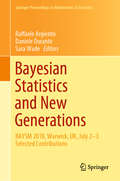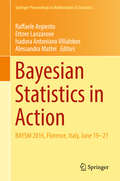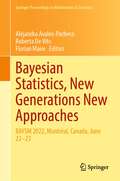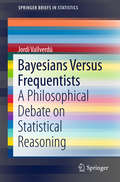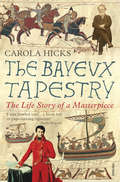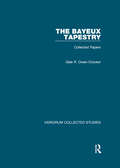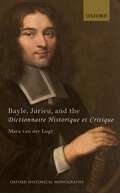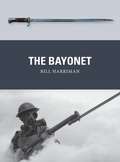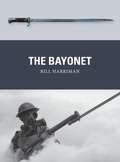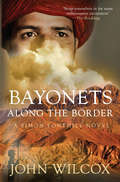- Table View
- List View
Bayesian Statistics and New Generations: BAYSM 2018, Warwick, UK, July 2-3 Selected Contributions (Springer Proceedings in Mathematics & Statistics #296)
by Raffaele Argiento Daniele Durante Sara WadeThis book presents a selection of peer-reviewed contributions to the fourth Bayesian Young Statisticians Meeting, BAYSM 2018, held at the University of Warwick on 2-3 July 2018. The meeting provided a valuable opportunity for young researchers, MSc students, PhD students, and postdocs interested in Bayesian statistics to connect with the broader Bayesian community. The proceedings offer cutting-edge papers on a wide range of topics in Bayesian statistics, identify important challenges and investigate promising methodological approaches, while also assessing current methods and stimulating applications. The book is intended for a broad audience of statisticians, and demonstrates how theoretical, methodological, and computational aspects are often combined in the Bayesian framework to successfully tackle complex problems.
Bayesian Statistics for Beginners: a step-by-step approach
by Therese M. Donovan Ruth M. MickeyBayesian statistics is currently undergoing something of a renaissance. At its heart is a method of statistical inference in which Bayes' theorem is used to update the probability for a hypothesis as more evidence or information becomes available. It is an approach that is ideally suited to making initial assessments based on incomplete or imperfect information; as that information is gathered and disseminated, the Bayesian approach corrects or replaces the assumptions and alters its decision-making accordingly to generate a new set of probabilities. As new data/evidence becomes available the probability for a particular hypothesis can therefore be steadily refined and revised. It is very well-suited to the scientific method in general and is widely used across the social, biological, medical, and physical sciences. Key to this book's novel and informal perspective is its unique pedagogy, a question and answer approach that utilizes accessible language, humor, plentiful illustrations, and frequent reference to on-line resources. Bayesian Statistics for Beginners is an introductory textbook suitable for senior undergraduate and graduate students, professional researchers, and practitioners seeking to improve their understanding of the Bayesian statistical techniques they routinely use for data analysis in the life and medical sciences, psychology, public health, business, and other fields.
Bayesian Statistics from Methods to Models and Applications: Research from BAYSM 2014 (Springer Proceedings in Mathematics & Statistics #126)
by Sylvia Frühwirth-Schnatter Angela Bitto Gregor Kastner Alexandra PosekanyThe Second Bayesian Young Statisticians Meeting (BAYSM 2014) and the research presented here facilitate connections among researchers using Bayesian Statistics by providing a forum for the development and exchange of ideas. WU Vienna University of Business and Economics hosted BAYSM 2014 from September 18th to the 19th. The guidance of renowned plenary lecturers and senior discussants is a critical part of the meeting and this volume, which follows publication of contributions from BAYSM 2013. The meeting's scientific program reflected the variety of fields in which Bayesian methods are currently employed or could be introduced in the future. Three brilliant keynote lectures by Chris Holmes (University of Oxford), Christian Robert (Université Paris-Dauphine), and Mike West (Duke University), were complemented by 24 plenary talks covering the major topics Dynamic Models, Applications, Bayesian Nonparametrics, Biostatistics, Bayesian Methods in Economics, and Models and Methods, as well as a lively poster session with 30 contributions. Selected contributions have been drawn from the conference for this book. All contributions in this volume are peer-reviewed and share original research in Bayesian computation, application, and theory.
Bayesian Statistics in Action: BAYSM 2016, Florence, Italy, June 19-21 (Springer Proceedings in Mathematics & Statistics #194)
by Raffaele Argiento Ettore Lanzarone Isadora Antoniano Villalobos Alessandra MatteiThis book is a selection of peer-reviewed contributions presented at the third Bayesian Young Statisticians Meeting, BAYSM 2016, Florence, Italy, June 19-21. The meeting provided a unique opportunity for young researchers, M.S. students, Ph.D. students, and postdocs dealing with Bayesian statistics to connect with the Bayesian community at large, to exchange ideas, and to network with others working in the same field. The contributions develop and apply Bayesian methods in a variety of fields, ranging from the traditional (e.g., biostatistics and reliability) to the most innovative ones (e.g., big data and networks).
Bayesian Statistics in Actuarial Science: with Emphasis on Credibility (Huebner International Series on Risk, Insurance and Economic Security #15)
by Stuart A. KlugmanThe debate between the proponents of "classical" and "Bayesian" statistica} methods continues unabated. It is not the purpose of the text to resolve those issues but rather to demonstrate that within the realm of actuarial science there are a number of problems that are particularly suited for Bayesian analysis. This has been apparent to actuaries for a long time, but the lack of adequate computing power and appropriate algorithms had led to the use of various approximations. The two greatest advantages to the actuary of the Bayesian approach are that the method is independent of the model and that interval estimates are as easy to obtain as point estimates. The former attribute means that once one learns how to analyze one problem, the solution to similar, but more complex, problems will be no more difficult. The second one takes on added significance as the actuary of today is expected to provide evidence concerning the quality of any estimates. While the examples are all actuarial in nature, the methods discussed are applicable to any structured estimation problem. In particular, statisticians will recognize that the basic credibility problem has the same setting as the random effects model from analysis of variance.
Bayesian Statistics, New Generations New Approaches: BAYSM 2022, Montréal, Canada, June 22–23 (Springer Proceedings in Mathematics & Statistics #435)
by Alejandra Avalos-Pacheco Roberta Vito Florian MaireThis book hosts the results presented at the 6th Bayesian Young Statisticians Meeting 2022 in Montréal, Canada, held on June 22–23, titled "Bayesian Statistics, New Generations New Approaches". This collection features selected peer-reviewed contributions that showcase the vibrant and diverse research presented at meeting. This book is intended for a broad audience interested in statistics and aims at providing stimulating contributions to theoretical, methodological, and computational aspects of Bayesian statistics. The contributions highlight various topics in Bayesian statistics, presenting promising methodological approaches to address critical challenges across diverse applications. This compilation stands as a testament to the talent and potential within the j-ISBA community. This book is meant to serve as a catalyst for continued advancements in Bayesian methodology and its applications and encourages fruitful collaborations that push the boundaries of statistical research.
Bayesian Survival Analysis (Springer Series in Statistics)
by Joseph G. Ibrahim Ming-Hui Chen Debajyoti SinhaSurvival analysis arises in many fields of study including medicine, biology, engineering, public health, epidemiology, and economics. This book provides a comprehensive treatment of Bayesian survival analysis. It presents a balance between theory and applications, and for each class of models discussed, detailed examples and analyses from case studies are presented whenever possible. The applications are all from the health sciences, including cancer, AIDS, and the environment.
Bayesian Tensor Decomposition for Signal Processing and Machine Learning: Modeling, Tuning-free Algorithms And Applications
by Lei Cheng Zhongtao Chen Yik-Chung WuBayesian Theory
by José M. Bernardo Adrian F. SmithThis highly acclaimed text, now available in paperback, provides a thorough account of key concepts and theoretical results, with particular emphasis on viewing statistical inference as a special case of decision theory. Information-theoretic concepts play a central role in the development of the theory, which provides, in particular, a detailed discussion of the problem of specification of so-called prior ignorance . The work is written from the authors s committed Bayesian perspective, but an overview of non-Bayesian theories is also provided, and each chapter contains a wide-ranging critical re-examination of controversial issues. The level of mathematics used is such that most material is accessible to readers with knowledge of advanced calculus. In particular, no knowledge of abstract measure theory is assumed, and the emphasis throughout is on statistical concepts rather than rigorous mathematics. The book will be an ideal source for all students and researchers in statistics, mathematics, decision analysis, economic and business studies, and all branches of science and engineering, who wish to further their understanding of Bayesian statistics
Bayesian Theory And Applications
by Paul Damien Petros Dellaportas Nicholas G. Polson David A. StephensThe development of hierarchical models and Markov chain Monte Carlo (MCMC) techniques forms one of the most profound advances in Bayesian analysis since the 1970s and provides the basis for advances in virtually all areas of applied and theoretical Bayesian statistics. This volume guides the reader along a statistical journey that begins with the basic structure of Bayesian theory, and then provides details on most of the past and present advances in this field. The book has a unique format. There is an explanatory chapter devoted to each conceptual advance followed by journal-style chapters that provide applications or further advances on the concept. Thus, the volume is both a textbook and a compendium of papers covering a vast range of topics. It is appropriate for a well-informed novice interested in understanding the basic approach, methods and recent applications. Because of its advanced chapters and recent work, it is also appropriate for a more mature reader interested in recent applications and developments, and who may be looking for ideas that could spawn new research. Hence, the audience for this unique book would likely include academicians/practitioners, and could likely be required reading for undergraduate and graduate students in statistics, medicine, engineering, scientific computation, business, psychology, bio-informatics, computational physics, graphical models, neural networks, geosciences, and public policy. The book honours the contributions of Sir Adrian F. M. Smith, one of the seminal Bayesian researchers, with his papers on hierarchical models, sequential Monte Carlo, and Markov chain Monte Carlo and his mentoring of numerous graduate students -the chapters are authored by prominent statisticians influenced by him. Bayesian Theory and Applications should serve the dual purpose of a reference book, and a textbook in Bayesian Statistics.
Bayesian Theory and Methods with Applications (Atlantis Studies in Probability and Statistics #1)
by Vladimir Savchuk Chris P. TsokosBayesian methods are growing more and more popular, finding new practical applications in the fields of health sciences, engineering, environmental sciences, business and economics and social sciences, among others. This book explores the use of Bayesian analysis in the statistical estimation of the unknown phenomenon of interest. The contents demonstrate that where such methods are applicable, they offer the best possible estimate of the unknown. Beyond presenting Bayesian theory and methods of analysis, the text is illustrated with a variety of applications to real world problems.
Bayesian Thinking in Biostatistics (Chapman & Hall/CRC Texts in Statistical Science)
by Gary L Rosner Purushottam W. Laud Wesley O. JohnsonPraise for Bayesian Thinking in Biostatistics: "This thoroughly modern Bayesian book …is a 'must have' as a textbook or a reference volume. Rosner, Laud and Johnson make the case for Bayesian approaches by melding clear exposition on methodology with serious attention to a broad array of illuminating applications. These are activated by excellent coverage of computing methods and provision of code. Their content on model assessment, robustness, data-analytic approaches and predictive assessments…are essential to valid practice. The numerous exercises and professional advice make the book ideal as a text for an intermediate-level course…" -Thomas Louis, Johns Hopkins University "The book introduces all the important topics that one would usually cover in a beginning graduate level class on Bayesian biostatistics. The careful introduction of the Bayesian viewpoint and the mechanics of implementing Bayesian inference in the early chapters makes it a complete self- contained introduction to Bayesian inference for biomedical problems….Another great feature for using this book as a textbook is the inclusion of extensive problem sets, going well beyond construed and simple problems. Many exercises consider real data and studies, providing very useful examples in addition to serving as problems." - Peter Mueller, University of Texas With a focus on incorporating sensible prior distributions and discussions on many recent developments in Bayesian methodologies, Bayesian Thinking in Biostatistics considers statistical issues in biomedical research. The book emphasizes greater collaboration between biostatisticians and biomedical researchers. The text includes an overview of Bayesian statistics, a discussion of many of the methods biostatisticians frequently use, such as rates and proportions, regression models, clinical trial design, and methods for evaluating diagnostic tests. Key Features Applies a Bayesian perspective to applications in biomedical science Highlights advances in clinical trial design Goes beyond standard statistical models in the book by introducing Bayesian nonparametric methods and illustrating their uses in data analysis Emphasizes estimation of biomedically relevant quantities and assessment of the uncertainty in this estimation Provides programs in the BUGS language, with variants for JAGS and Stan, that one can use or adapt for one's own research The intended audience includes graduate students in biostatistics, epidemiology, and biomedical researchers, in general Authors Gary L. Rosner is the Eli Kennerly Marshall, Jr., Professor of Oncology at the Johns Hopkins School of Medicine and Professor of Biostatistics at the Johns Hopkins Bloomberg School of Public Health. Purushottam (Prakash) W. Laud is Professor in the Division of Biostatistics, and Director of the Biostatistics Shared Resource for the Cancer Center, at the Medical College of Wisconsin. Wesley O. Johnson is professor Emeritus in the Department of Statistics as the University of California, Irvine.
Bayesian Thinking in Biostatistics (Chapman & Hall/CRC Texts in Statistical Science)
by Gary L Rosner Purushottam W. Laud Wesley O. JohnsonPraise for Bayesian Thinking in Biostatistics: "This thoroughly modern Bayesian book …is a 'must have' as a textbook or a reference volume. Rosner, Laud and Johnson make the case for Bayesian approaches by melding clear exposition on methodology with serious attention to a broad array of illuminating applications. These are activated by excellent coverage of computing methods and provision of code. Their content on model assessment, robustness, data-analytic approaches and predictive assessments…are essential to valid practice. The numerous exercises and professional advice make the book ideal as a text for an intermediate-level course…" -Thomas Louis, Johns Hopkins University "The book introduces all the important topics that one would usually cover in a beginning graduate level class on Bayesian biostatistics. The careful introduction of the Bayesian viewpoint and the mechanics of implementing Bayesian inference in the early chapters makes it a complete self- contained introduction to Bayesian inference for biomedical problems….Another great feature for using this book as a textbook is the inclusion of extensive problem sets, going well beyond construed and simple problems. Many exercises consider real data and studies, providing very useful examples in addition to serving as problems." - Peter Mueller, University of Texas With a focus on incorporating sensible prior distributions and discussions on many recent developments in Bayesian methodologies, Bayesian Thinking in Biostatistics considers statistical issues in biomedical research. The book emphasizes greater collaboration between biostatisticians and biomedical researchers. The text includes an overview of Bayesian statistics, a discussion of many of the methods biostatisticians frequently use, such as rates and proportions, regression models, clinical trial design, and methods for evaluating diagnostic tests. Key Features Applies a Bayesian perspective to applications in biomedical science Highlights advances in clinical trial design Goes beyond standard statistical models in the book by introducing Bayesian nonparametric methods and illustrating their uses in data analysis Emphasizes estimation of biomedically relevant quantities and assessment of the uncertainty in this estimation Provides programs in the BUGS language, with variants for JAGS and Stan, that one can use or adapt for one's own research The intended audience includes graduate students in biostatistics, epidemiology, and biomedical researchers, in general Authors Gary L. Rosner is the Eli Kennerly Marshall, Jr., Professor of Oncology at the Johns Hopkins School of Medicine and Professor of Biostatistics at the Johns Hopkins Bloomberg School of Public Health. Purushottam (Prakash) W. Laud is Professor in the Division of Biostatistics, and Director of the Biostatistics Shared Resource for the Cancer Center, at the Medical College of Wisconsin. Wesley O. Johnson is professor Emeritus in the Department of Statistics as the University of California, Irvine.
The Bayesian Way: Introductory Statistics For Economists And Engineers
by Svein Olav NybergA comprehensive resource that offers an introduction to statistics with a Bayesian angle, for students of professional disciplines like engineering and economics The Bayesian Way offers a basic introduction to statistics that emphasizes the Bayesian approach and is designed for use by those studying professional disciplines like engineering and economics. In addition to the Bayesian approach, the author includes the most common techniques of the frequentist approach. Throughout the text, the author covers statistics from a basic to a professional working level along with a practical understanding of the matter at hand. Filled with helpful illustrations, this comprehensive text explores a wide range of topics, starting with descriptive statistics, set theory, and combinatorics. The text then goes on to review fundamental probability theory and Bayes' theorem. The first part ends in an exposition of stochastic variables, exploring discrete, continuous and mixed probability distributions. In the second part, the book looks at statistical inference. Primarily Bayesian, but with the main frequentist techniques included, it covers conjugate priors through the powerful yet simple method of hyperparameters. It then goes on to topics in hypothesis testing (including utility functions), point and interval estimates (including frequentist confidence intervals), and linear regression. This book: Explains basic statistics concepts in accessible terms and uses an abundance of illustrations to enhance visual understanding Has guides for how to calculate the different probability distributions, functions , and statistical properties, on platforms like popular pocket calculators and Mathematica / Wolfram Alpha Includes example-proofs that enable the reader to follow the reasoning Contains assignments at different levels of difficulty from simply filling out the correct formula to the complex multi-step text assignments Offers information on continuous, discrete and mixed probability distributions, hypothesis testing, credible and confidence intervals, and linear regression Written for undergraduate and graduate students of subjects where Bayesian statistics are applied, including engineering, economics, and related fields, The Bayesian Way: With Applications in Engineering and Economics offers a clear understanding of Bayesian statistics that have real-world applications.
The Bayesian Way: Introductory Statistics For Economists And Engineers
by Svein Olav NybergA comprehensive resource that offers an introduction to statistics with a Bayesian angle, for students of professional disciplines like engineering and economics The Bayesian Way offers a basic introduction to statistics that emphasizes the Bayesian approach and is designed for use by those studying professional disciplines like engineering and economics. In addition to the Bayesian approach, the author includes the most common techniques of the frequentist approach. Throughout the text, the author covers statistics from a basic to a professional working level along with a practical understanding of the matter at hand. Filled with helpful illustrations, this comprehensive text explores a wide range of topics, starting with descriptive statistics, set theory, and combinatorics. The text then goes on to review fundamental probability theory and Bayes' theorem. The first part ends in an exposition of stochastic variables, exploring discrete, continuous and mixed probability distributions. In the second part, the book looks at statistical inference. Primarily Bayesian, but with the main frequentist techniques included, it covers conjugate priors through the powerful yet simple method of hyperparameters. It then goes on to topics in hypothesis testing (including utility functions), point and interval estimates (including frequentist confidence intervals), and linear regression. This book: Explains basic statistics concepts in accessible terms and uses an abundance of illustrations to enhance visual understanding Has guides for how to calculate the different probability distributions, functions , and statistical properties, on platforms like popular pocket calculators and Mathematica / Wolfram Alpha Includes example-proofs that enable the reader to follow the reasoning Contains assignments at different levels of difficulty from simply filling out the correct formula to the complex multi-step text assignments Offers information on continuous, discrete and mixed probability distributions, hypothesis testing, credible and confidence intervals, and linear regression Written for undergraduate and graduate students of subjects where Bayesian statistics are applied, including engineering, economics, and related fields, The Bayesian Way: With Applications in Engineering and Economics offers a clear understanding of Bayesian statistics that have real-world applications.
Bayesians Versus Frequentists: A Philosophical Debate on Statistical Reasoning (SpringerBriefs in Statistics #0)
by Jordi VallverdúThis book analyzes the origins of statistical thinking as well as its related philosophical questions, such as causality, determinism or chance. Bayesian and frequentist approaches are subjected to a historical, cognitive and epistemological analysis, making it possible to not only compare the two competing theories, but to also find a potential solution. The work pursues a naturalistic approach, proceeding from the existence of numerosity in natural environments to the existence of contemporary formulas and methodologies to heuristic pragmatism, a concept introduced in the book’s final section. This monograph will be of interest to philosophers and historians of science and students in related fields. Despite the mathematical nature of the topic, no statistical background is required, making the book a valuable read for anyone interested in the history of statistics and human cognition.
The Bayeux Tapestry: The Life Story of a Masterpiece
by Carola HicksThe vivid scenes on the Bayeux Tapestry depict the events leading up to the Battle of Hastings in 1066. It is one of Europe's greatest treasures and its own story is full of drama and surprise. Who commissioned the tapestry? Was it Bishop Odo, William's ruthless half-brother? Or Harold's dynamic sister Edith, juggling for a place in the new court? Hicks shows us this world and the miracle of the tapestry's making: the stitches, dyes and strange details in the margins. For centuries it lay ignored in Bayeux cathedral until its 'discovery' in the eighteenth century. It became a symbol of power as well as art: townsfolk saved it during the French Revolution; Napoleon displayed it to promote his own conquest; the Nazis strove to make it their own; and its influence endures today. This marvellous book, packed with thrilling stories, shows how we remake history in every age and how a great work of art has a life of its own.
The Bayeux Tapestry: Collected Papers
by Gale R. Owen-CrockerThis collection of fifteen papers ranges from the author's initial interest in the Tapestry as a source of information on early medieval dress, through to her startling recognition of the embroidery's sophisticated narrative structure. Developing the work of previous authors who had identified graphic models for some of the images, she argues that not just the images themselves but the contexts from which they were drawn should be taken in to account in 'reading' the messages of the Tapestry. In further investigating the minds and hands behind this, the largest non-architectural artefact surviving from the Middle Ages, she ranges over the seams, the embroidery stitches, the language and artistry of the inscription, the potential significance of borders and the gestures of the figures in the main register, always scrutinising detail informatively. She identifies an over-riding conception and house style in the Tapestry, but also sees different hands at work in both needlecraft and graphics. Most intriguingly, she recognises an sub-contractor with a Roman source and a clownish wit. The author is Professor of Anglo-Saxon Culture at The University of Manchester, UK, a specialist in Old English poetry, Anglo-Saxon material culture and medieval dress and textiles.
The Bayeux Tapestry: Collected Papers
by Gale R. Owen-CrockerThis collection of fifteen papers ranges from the author's initial interest in the Tapestry as a source of information on early medieval dress, through to her startling recognition of the embroidery's sophisticated narrative structure. Developing the work of previous authors who had identified graphic models for some of the images, she argues that not just the images themselves but the contexts from which they were drawn should be taken in to account in 'reading' the messages of the Tapestry. In further investigating the minds and hands behind this, the largest non-architectural artefact surviving from the Middle Ages, she ranges over the seams, the embroidery stitches, the language and artistry of the inscription, the potential significance of borders and the gestures of the figures in the main register, always scrutinising detail informatively. She identifies an over-riding conception and house style in the Tapestry, but also sees different hands at work in both needlecraft and graphics. Most intriguingly, she recognises an sub-contractor with a Roman source and a clownish wit. The author is Professor of Anglo-Saxon Culture at The University of Manchester, UK, a specialist in Old English poetry, Anglo-Saxon material culture and medieval dress and textiles.
Bayle, Jurieu, and the Dictionnaire Historique et Critique (Oxford Historical Monographs)
by Mara van der LugtBayle, Jurieu and the Dictionnaire Historique et Critique presents a new study of Pierre Bayle's Dictionnaire Historique et Critique (1696), with special reference to Bayle's polemical engagement with the theologian Pierre Jurieu. While recent years have seen a surge of interest in Bayle, there is as yet no consensus on how to interpret Bayle's ambiguous stance on reason and religion, and how to make sense of the Dictionnaire: although specific parts of the Dictionnaire have received much scholarly attention, the work has hardly been studied as a whole, and little is known about how the Dictionnaire was influenced by Bayle's polemic with Jurieu. This volume aims to establish a new method for reading the Dictionnaire, under a dual premise: first, that the work can only be rightly understood when placed within the immediate context of its production in the 1690s; second, that it is only through an appreciation of the mechanics of the work as a whole, and of the role played by its structural and stylistic particularities, that we can attain an appropriate interpretation of its parts. Special attention is paid to the heated theological-political conflict between Bayle and Jurieu in the 1690s, which had a profound influence on the project of the dictionary and on several of its major themes, such as the tensions in the relationship between the intellectual sphere of the Republic of Letters and the political state, but also the danger of religious fanaticism spurring intolerance and war. The final chapters demonstrate that Bayle's clash with Jurieu was also one of the driving forces behind Bayle's reflection on the problem of evil; they expose the fundamentally problematic nature of both Bayle's theological association with Jurieu, and his self-defence in the second edition of the Dictionnaire.
Bayley 4 Clinical Use and Interpretation (Practical Resources for the Mental Health Professional)
by Glen P. AylwardBayley 4 Clinical Use and Interpretation provides clinicians with a guide for use, administration, scoring and interpretation of the Bayley Scales of Infant and Toddler Development, Fourth Edition. The book begins with why and how the Bayley 4 was revised. Separate chapters discuss the clinical use and interpretation of the cognitive, language, motor, social-emotional and adaptive scales, each with illustrative clinical cases. Recommendations are provided to aid clinicians in the efficiency of test administration, as well as how to interpret and integrate results within a diagnostic assessment format and in planning intervention. The clinical validity of the Bayley 4 is demonstrated for eight clinical groups. There is an overview of Autism Spectrum Disorder (ASD) with the Bayley 4 ASD Checklist, accommodations, and red flags indicative of abnormality. Additional chapters discuss digital administration and how to present feedback to caregivers. - Summarizes what is new and different in the Bayley 4 - Guides clinicians in use, administration, scoring, and interpretation - Identifies the clinical validity of Bayley 4 for eight clinical groups - Suggests how to integrate results into assessment and intervention - Includes use for autism assessment and an ASD checklist - Provides case studies on typical and atypical development
Bayley-III Clinical Use and Interpretation (Practical Resources for the Mental Health Professional)
by Lawrence G. Weiss, Thomas Oakland, Glen P. AylwardOne of the most widely used assessments of infants and toddlers, the BAYLEY-III measures the major areas of development including cognitive, language, motor, social-emotional, and adaptive functioning. This book provides an introduction into use of the BAYLEY-III in each of these five areas. For each of these areas, individual chapters cover the relevant test content, administration, scoring, interpretation, strengths / concerns, and uses in clinical populations. Each chapter also includes a real life case study demonstrating typical performance of a child with delays one of the five areas of development. The book concludes with a special chapter on procedures for brief neurodevelopmental screening of infants in pediatric settings. Covering all major areas of development, the book is informative for a wide range of professionals who use the BAYLEY-III to evaluate development of infants and toddlers from multiple perspectives including psychology, speech and language, and occupational/physical therapy. - Provides an overview of the theoretical background and structure of BAYLEY-III written by the lead Research Director - Introduces practitioners to the test content in each of the five major areas of child development covered by the BAYLEY-III: cognitive, language, motor, social-emotional, and adaptive functioning - Readers will learn how to competently administer, score, and interpret each of the five scales in the BAYLEY-III - Explains the strengths and limitations of the test in each of the five areas it measures - Instructs readers on uses of the test in specific clinical populations - Includes five case studies showing typical patterns of children delayed in one of the five areas of development - Concludes with a special chapter on neurodevelopmental screening procedures in pediatric settings
The Bayonet (Weapon)
by Bill HarrimanAlthough muskets delivered devastating projectiles at comparatively long ranges, their slow rate of fire left the soldier very vulnerable while reloading, and early muskets were useless for close-quarter fighting. Consequently, European infantry regiments of the 17th century were composed of both musketeers and pikemen, who protected the musketeers while loading but also formed the shock component for close-quarter combat. The development of the flintlock musket produced a much less cumbersome and faster-firing firearm. When a short knife was stuck into its muzzle, every soldier could be armed with a missile weapon as well as one that could be used for close combat. The only disadvantage was that the musket could not be loaded or fired while the plug bayonet was in place. The socket bayonet solved this problem and the musket/bayonet combination became the universal infantry weapon from c.1700 to c.1870. The advent of shorter rifled firearms saw the attachment of short swords to rifle barrels. Their longer blades still gave the infantryman the 'reach' that contemporaries believed he needed to fend off cavalry attacks. The perfection of the small-bore magazine rifle in the 1890s saw the bayonet lose its tactical importance, becoming smaller and more knife-like, a trend that continued in the world wars. When assault rifles predominated from the 1950s onwards, the bayonet became a weapon of last resort. Its potential usefulness continued to be recognized, but its blade was often combined with an item with some additional function, most notably a wire-cutter. Ultimately, for all its fearsome reputation as a visceral, close-quarter fighting weapon, the bayonet's greatest impact was actually as a psychological weapon. Featuring full-colour artwork as well as archive and close-up photographs, this is the absorbing story of the complementary weapon to every soldier's firearm from the army of Louis XIV to modern-day forces in all global theatres of conflict.
The Bayonet (Weapon)
by Bill HarrimanAlthough muskets delivered devastating projectiles at comparatively long ranges, their slow rate of fire left the soldier very vulnerable while reloading, and early muskets were useless for close-quarter fighting. Consequently, European infantry regiments of the 17th century were composed of both musketeers and pikemen, who protected the musketeers while loading but also formed the shock component for close-quarter combat. The development of the flintlock musket produced a much less cumbersome and faster-firing firearm. When a short knife was stuck into its muzzle, every soldier could be armed with a missile weapon as well as one that could be used for close combat. The only disadvantage was that the musket could not be loaded or fired while the plug bayonet was in place. The socket bayonet solved this problem and the musket/bayonet combination became the universal infantry weapon from c.1700 to c.1870. The advent of shorter rifled firearms saw the attachment of short swords to rifle barrels. Their longer blades still gave the infantryman the 'reach' that contemporaries believed he needed to fend off cavalry attacks. The perfection of the small-bore magazine rifle in the 1890s saw the bayonet lose its tactical importance, becoming smaller and more knife-like, a trend that continued in the world wars. When assault rifles predominated from the 1950s onwards, the bayonet became a weapon of last resort. Its potential usefulness continued to be recognized, but its blade was often combined with an item with some additional function, most notably a wire-cutter. Ultimately, for all its fearsome reputation as a visceral, close-quarter fighting weapon, the bayonet's greatest impact was actually as a psychological weapon. Featuring full-colour artwork as well as archive and close-up photographs, this is the absorbing story of the complementary weapon to every soldier's firearm from the army of Louis XIV to modern-day forces in all global theatres of conflict.
Bayonets Along the Border: A Simon Fonthill Novel (Simon Fonthill #10)
by John WilcoxNorth West India, July 1897. Simon and Alice Fonthill are travelling with their old friend Jenkins to Marden, India for a 50th anniversary party with the Guides Corps. What begins as a peaceful journey becomes a dangerous battle as they find themselves ambushed by four Pathans. On arrival at Marden, their suspicions of conflict are confirmed as they are told of fresh trouble from the Pathans leading Simon and his comrade, 352 Jenkins, to join the charge in protecting a nearby fort.Afterwards, their respite is short-lived when Simon is tasked by Viceroy Elgin to deliver a very important letter to the Amir in Kabul. For her safety, Alice only travels as far as fort Landi Kotal in the Khyber Pass. But strife prevails throughout the land; tribe fights with tribe and every man is a soldier ready to bloody his hands. Undertaking his mission in Kabul, Fonthill learns from the Amir that an army is heading towards the Pass to seize the forts and will undoubtedly leave most for dead.Can Fonthill and Jenkins battle their way back across the Pass to the fort? And will they make it in time to rescue Alice or will the merciless Pathans get there first?
